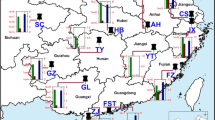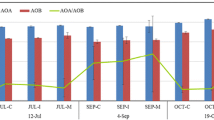Abstract
Soil pH has been suggested as one of the most important factors affecting the ecological characteristics of soil ammonia-oxidizers (AO), which mediate the conversion of ammonia to nitrate via nitrite and contribute significantly to the leaching of nitrate to groundwater and the production of atmospheric nitrous oxide (N2O). However, the dynamics of the AO community in acidic purple soils, which are widely distributed in Southwest China, remain largely unknown. In this study, two typical purple soils with different pH values (acidic: ACI; alkaline: ALK) were collected and studied. The abundance of amoA (gene encoding ammonia monooxygenase) of ammonia-oxidizing bacteria (AOB) and archaea (AOA) and that of the cbbL gene (encoding ribulose-1,5-biphosphate carboxylase/oxygenase) were determined by real-time PCR, and the community structures of AOB and AOA were investigated by cloning and sequencing. The results revealed that abundances of AOB and AOA were significantly lower in the ACI purple soil sample than in the ALK sample, but a higher ratio of AOA to AOB was found in the ACI purple soil sample. No significant difference in the abundance of cbbL was found between the two soils, but the ratio of AOB and AOA amoA to cbbL genes in the ACI soil samples was higher than that in the ALK sample. Moreover, the ALK and ACI soils harbored contrasting community compositions of AO. AOB in the ALK were dominated by cluster 3a (87 %), while the percentage of cluster 3a decreased and clusters 9 and 10 accounted for almost 77 % of the AOB community in the ACI soil. Nitrososphaera and Nitrosotalea were the major AOA phylotypes in the ALK and ACI soils, respectively. In conclusion, our results revealed the potential relations among pH, AO, and total chemoautotrophic bacteria in soil and that pH might have an essential impact on the adaptation and selection of AO in purple soils.




Similar content being viewed by others
References
Andert J, Wessen E, Borjesson G, Hallin S (2011) Temporal changes in abundance and composition of ammonia-oxidizing bacterial and archaeal communities in a drained peat soil in relation to N2O emissions. J Soils Sediments 11:1399–1407
Blainey PC, Mosier AC, Potanina A, Francis CA, Quake SR (2011) Genome of a low-salinity ammonia-oxidizing archaeon determined by single-cell and metagenomic analysis. PLoS One 6:e16626
Cao P, Zhang LM, Shen JP, Zheng YM, Di HJ, He JZ (2012) Distribution and diversity of archaeal communities in selected Chinese soils. FEMS Microbiol Ecol 80:146–158
Chen X, Zhang LM, Shen JP, Wei WX, He JZ (2011) Abundance and community structure of ammonia-oxidizing archaea and bacteria in an acid paddy soil. Biol Fert Soils 47:323–331
De la Torre JR, Walk CB, Ingalls AE, Konneke M, Stahl DA (2008) Cultivation of a thermophilic ammonia oxidizing archaeon synthesizing crenarchaeol. Environ Microbiol 10:810–818
Deboer W, Gunnewiek P, Veenhuis M, Bock E, Laanbroek HJ (1991) Nitrification at low pH by aggregated chemolithotrophic bacteria. Appl Environ Microbiol 57:3600–3604
Erguder TH, Boon N, Wittebolle L, Marzorati M, Verstraete W (2009) Environmental factors shaping the ecological niches of ammonia-oxidizing archaea. FEMS Microbiol Rev 33:855–869
Francis CA, Roberts KJ, Beman JM, Santoro AE, Oakley BB (2005) Ubiquity and diversity of ammonia-oxidizing archaea in water columns and sediments of the ocean. Proc Natl Acad Sci USA 102:14683–14688
Gubry-Rangin C, Hai B, Quince C, Engel M, Thomson BC, James P, Schloter M, Griffiths RI, Prosser JI, Nicol GW (2011) Niche specialization of terrestrial archaeal ammonia oxidizers. Proc Natl Acad Sci USA 108:21206–21211
Hallin S, Jones CM, Schloter M, Philippot L (2009) Relationship between N-cycling communities and Distribution of N-cycling microbial communities in a 50-year-old fertilization experiment. ISME J 3:597–605
He RY (2003) Purple soil in China (2). China Science Press, Beijing China
He JZ, Shen JP, Zhang LM, Zhu YG, Zheng YM, Xu MG, Di HJ (2007) Quantitative analyses of the abundance and composition of ammonia-oxidizing bacteria and ammonia-oxidizing archaea of a Chinese upland red soil under long-term fertilization practices. Environ Microbiol 9:2364–2374
He JZ, Hu HW, Zhang LM (2012) Current insights into the autotrophic thaumarchaeal ammonia oxidation in acidic soils. Soil Biol Biochem 55:146–154
Hu HW, Zhang LM, Dai Y, Di HJ, He JZ (2013) pH-dependent distribution of soil ammonia oxidizers across a large geographical scale as revealed by high-throughput pyrosequencing. J Soils Sediments 13:1439–1449
Hu BL, Liu S, Wang W, Shen LD, Lou LP, Liu WP, Tian GM, Xu XY, Zheng P (2014) pH-dominated niche segregation of ammonia-oxidising microorganisms in Chinese agricultural soils. FEMS Microbiol Ecol 90:290–299
Isobe K, Koba K, Suwa Y, Ikutani J, Fang YT, Yoh M, Mo JM, Otsuka S, Senoo K (2012) High abundance of ammonia-oxidizing archaea in acidified subtropical forest soils in southern China after long-term N deposition. FEMS Microbiol Ecol 80:193–203
Jiang YJ, Jin C, Sun B (2014) Soil aggregate stratification of nematodes and ammonia oxidizers affects nitrification in an acid soil. Environ Microbiol 16:3083–3094
Kim JG, Jung MY, Park SJ, Rijpstra WIC, Damste JSS, Madsen EL, Min D, Kim JS, Kim GJ, Rhee SK (2012) Cultivation of a highly enriched ammonia-oxidizing archaeon of thaumarchaeotal group I.1b from an agricultural soil. Environ Microbiol 14:1528–1543
Konneke M, Bernhard AE, de la Torre JR, Walker CB, Waterbury JB, Stahl DA (2005) Isolation of an autotrophic ammonia-oxidizing marine archaeon. Nature 437:543–546
Kowalchuk GA, Stephen JR (2001) Ammonia-oxidizing bacteria: a model for molecular microbial ecology. Annu Rev Microbiol 55:485–529
Kurola J, Salkinoja-Salonen M, Aarnio T, Hultman J, Romantschuk M (2005) Activity, diversity and population size of ammoniaoxidising bacteria in oil-contaminated landfarming soil. FEMS Microbiol Lett 250:33–38
Kusian B, Bowien B (1997) Organization and regulation of cbb CO2 assimilation genes in autotrophic bacteria. FEMS Microbiol Rev 21:135–155
Lehtovirta-Morley LE, Stoecker K, Vilcinskas A, Prosser JI, Nicol GW (2011) Cultivation of an obligate acidophilic ammonia oxidizer from a nitrifying acid soil. Proc Natl Acad Sci USA 108:15892–15897
Lu RK (1999) Methods of Agrochemical Soil Analysis. China Agricultural Science Press, Beijing China
Nicol GW, Leininger S, Schleper C, Prosser JI (2008) The influence of soil pH on the diversity, abundance and transcriptional activity of ammonia oxidizing archaea and bacteria. Environ Microbiol 10:2966–2978
Pester M, Rattel T, Flechl S, Grongroft A, Rlchter A, Overmann J, Relnhold-Hurek B, Loy A, Wagner M (2012) amoA-based consensus phylogeny of ammonia-oxidizing archaea and deep sequencing of amoA genes from soils of four different geographic regions. Environ Microbiol 14:525–539
Prosser JI, Nicol GW (2012) Archaeal and bacterial ammonia-oxidisers in soil: the quest for niche specialization and differentiation. Trends Microbiol 20:523–531
Ravishankara AR, Daniel JS, Portmann RW (2009) Nitrous oxide (N2O): The dominant ozone-depleting substance emitted in the 21st century. Science 326:123–125
Rotthauwe JH, Witzel KP, Liesack W (1997) The ammonia monooxygenase structural gene amoA as a functional marker: molecular fine-scale analysis of natural ammonia-oxidizing populations. Appl Environ Microbiol 63:4704–4712
Schmidt I (2009) Chemoorganoheterotrophic growth of Nitrosomonas europaea and Nitrosomonas eutropha. Curr Microbiol 59:130–138
Selesi D, Pattis I, Schmid M, Kandeler E, Hartmann A (2007) Quantification of bacterial RubisCO genes in soils by cbbL targeted real-time PCR. J Microbiol Method 69:497–503
Shen JP, Zhang LM, Zhu YG, Zhang JB, He JZ (2008) Abundance and composition of ammonia-oxidizing bacteria and ammonia-oxidizing archaea communities of an alkaline sandy loam. Environ Microbiol 10:1601–1611
Shen JP, Zhang LM, He JZ (2014) constrasting response of nitrification capacity in three agricultural soils to N addition during short-term incubation. J Soils Sediments 14:1861–1868
Stopnisek N, Gubry-Rangin C, Hofferle S, Nicol GW, Mandic-Mulec I, Peosser JI (2010) Thaumarchaeal ammonia oxidation in an acidic forest peat soil is not influenced by ammonium amendment. Appl Environ Microbiol 76:7626–7634
Tamura K, Dudley J, Nei M, Kumar S (2007) MEGA4: molecular evolutionary genetics analysis (MEGA) software version 4.0. Mol Biol Evol 24:1596–1599
Tolli J, King GM (2005) Diversity and structure of bacterial chemolithotrophic communities in pine forest and agroecosystem soils. Appl Environ Microbiol 71:8411–8418
Tourna M, Stieglmeier M, Spang A, Konneke M, Schintlmeister A, Urich T, Engel M, Schloter M, Wagner M, Richter A, Schleper C (2011) Nitrososphaera viennensis, an ammonia oxidizing archaeon from soil. Proc Natl Acad Sci USA 108:8420–8425
Videmsek U, Hagn A, Suhadolc M, Radl V, Knicker H, Schloter M, Vodnik D (2009) Abundance and diversity of CO2-fixing bacteria in grassland soils close to natural carbon dioxide springs. Microb Ecol 58:1–9
Wessen E, Nyberg K, Jansson JK, Hallin S (2011) Responses of bacterial and archaeal ammonia oxidizers to soil organic and fertilizer amendments under long-term management. Appl Soil Ecol 45:193–200
Wu XH, Ge TD, Yuan HZ, Zhou P, Chen XB, Chen S, Brookes P, Wu JS (2014) Evaluation of optimal extraction method for measuring D-ribulose-1,5-bisphosphate carboxylase/oxgenase (RubisCO) in agricultural soils and its association with soil microbial CO2 assimilation. Pedobiologia 57:277–284
Xiao KQ, Bao P, Bao QL, Jia Y, Huang FY, Su JQ, Zhu YG (2014) Quantative analyses of ribulose-1,5-bisphosphate carboxylase/oxygenase (RubisCO) large-subunit genes (cbbL) in typical paddy soils. FEMS Microbiol Ecol 87:89–101
Yao HY, Gao YM, Nicol GW, Campbell CD, Prosser JI, Zhang L, Han W, Singh BK (2011) Links between ammonia oxidizer community structure, abundance, and nitrification potential in acidic soils. Appl Environ Microbiol 77:4618–4625
Yao HY, Campbell CD, Chapman SJ, Freitag TE, Nicol GW, Singh BK (2013) Multi-factorial drivers of ammonia oxidizer communities: evidence from a national soil survey. Environ Microbiol 15:2545–2556
Ying JY, Zhang LM, He JZ (2010) Putative ammonia-oxidizing bacteria and archaea in an acidic red soil with different land utilization patterns. Environ Microbiol Rep 2:304–312
Yuan HZ, Ge TD, Zou SY, Wu XH, Liu SL, Zhou P, Chen XJ, Brookes P, Wu JS (2013) Effect of land use on the abundance and diversity of autotrophic bacteria as measured by ribulose-1,5-biphosphate carboxylase/oxgenase (RubisCO) large subunit gene abundance in soils. Biol Fert Soils 49:609–616
Zhalnina K, de Quadros PD, Camargo FAO, Triplett EW (2012) Drivers of archaeal ammonia-oxidizing communities in soil. Front Microbiol 3:210
Zhang LM, Hu HW, Shen JP, He JZ (2012) Ammonia-oxidizing archaea have more important role than ammonia-oxidizing bacteria in ammonia oxidation of strongly acidic soils. ISME J 6:1032–1045
Zhou ZF, Shi XJ, Zheng Y, Qin ZX, Xie DT, Li ZL, Guo T (2014) Abundance and community structure of ammonia-oxidizing bacteria and archaea in purple soil under long-term fertilization. Eur J Soil Biol 60:24–33
Acknowledgments
This work was supported by the National Natural Science Foundation of China (41371477), China Postdoctoral Science Foundation (2013 M531928), and the Fundamental Research Funds for the Central Universities (XDJK2014B047).
Author information
Authors and Affiliations
Corresponding author
Rights and permissions
About this article
Cite this article
Zhou, ZF., Wang, MX., Liu, WL. et al. A comparative study of ammonia-oxidizing archaea and bacteria in acidic and alkaline purple soils. Ann Microbiol 66, 615–623 (2016). https://doi.org/10.1007/s13213-015-1143-9
Received:
Accepted:
Published:
Issue Date:
DOI: https://doi.org/10.1007/s13213-015-1143-9




